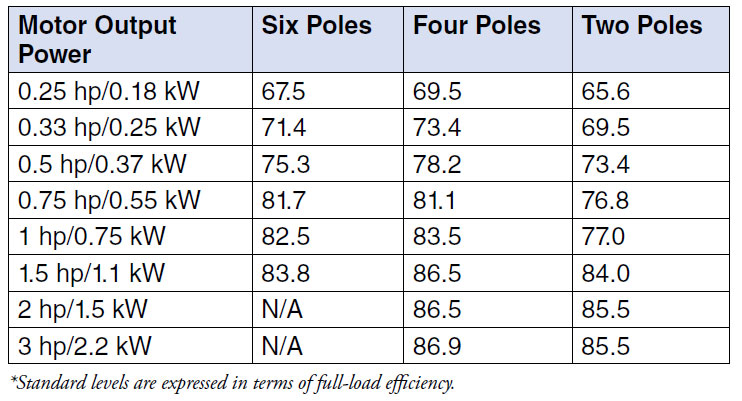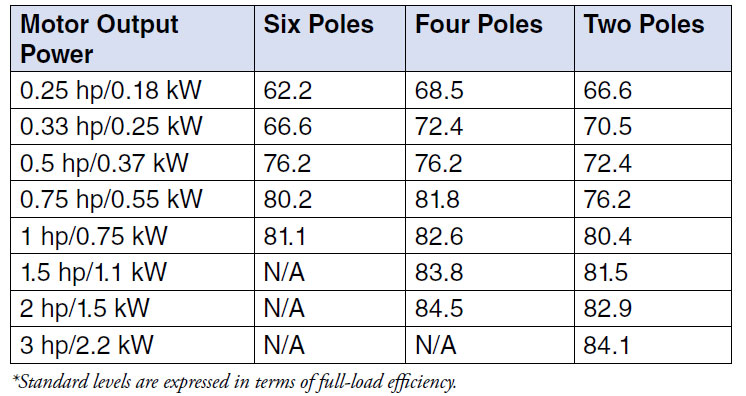What pump manufacturers and pump users need to know about small electric motor regulations. Second of Two Parts.
Part One of this two-part article discussed Integral HP AC Motors from 1 to 500 hp covered by the Energy Independence and Security Act of 2007 (EISA). Part Two addresses the new minimum efficiency small electric motor regulations introduced earlier this year.
For the first time, the United States Department of Energy (DOE) adopted energy conservation standards for small electric motors in February 2010. DOE determined these standards will result in significant conservation of energy, and are technologically feasible and economically justified. Motors covered under these new regulations range from ¼ to 3 hp and include single and poly phase two, four and six pole general purpose motors in NEMA 42, 48 and 56 frames and corresponding IEC equivalent motors and frames. The new regulations will take effect in 2015, which is five years after the original publish date.
Tables 1 and 2 show these new minimum efficiency standard levels, which apply to all small electric motors manufactured for sale in the United States, or imported into the U.S. either as standalone items or as a part of a system.

Table 1. Standard levels for polyphase small electric motor

Table 2. Standard levels for capacitor-start induction-run and capacitor-start capacitor-run small electric motors
Potential Estimated Energy Savings from Small Electric Motor Rule
It is not possible to understand the impact of this new law on pump manufacturers or pump end users by simply looking at Tables 1 and 2. To help define the impact these changes will have with regard to energy savings, the DOE estimates the standards will save approximately 2.2 quads (quadrillion or 1015 British Thermal Units (BTU)) of energy during 30 years (2015-2045), which is the expected life of these new higher efficiency motors. This is equivalent to about 2.2 percent of total annual U.S. energy consumption.
One quad of energy is equal to more than eight billion gallons of gasoline or 36 million tons of coal. During this 30 year period, the DOE expects the energy savings from these new standards will eliminate the need for approximately eight new 250 MW power plants. The resulting carbon dioxide (CO2) reduction will be equivalent to an amount equal to that produced by approximately 25 million new cars in a year. The new standards will also reduce air pollution by eliminating production of approximately 81,000 tons (kt) of nitrogen oxides (NOX) emissions and approximately 0.49 ton of cumulative mercury (Hg) pollution will be avoided. The climate-related impacts as a result of this new motor regulation for these pollutants will be beneficial to all.
Compliance: Design Changes, Testing and Certification
To comply with the new regulations, motor manufacturers will need to change original motor designs significantly. Since additional active materials, like copper and steel, will be needed in motor designs to increase efficiency, the overall cost of motors will likely increase. Changes in manufacturing tooling to build more efficient designs may also be required. Non-recurring engineering may also drive costs higher as motor designs will need to change to achieve these higher efficiency levels. It is expected, however, that the resulting energy savings will cover most, if not all, of the additional first cost of the new designs for the end users. These potential increases in costs could be passed along to pump OEMs and pump end users.
For pump manufacturers who purchase all of their motors and do not re-label them as their own, the motor manufacturer will most likely be responsible for the testing and documentation required to comply. Pump manufacturers who manufacture small electric motors, or re-label these motors from a motor supplier, will need to conduct the required testing and maintain careful documentation of test results.
With the increasing efforts to reduce product costs, it is common for equipment manufacturers and plant buyers to source motors for their equipment from low-cost regions. Motor manufacturers in these regions may not be familiar with the new federal requirements, which may result in negligence on the issue of compliance. Today, the equipment user or specifier must be proactive to ensure the manufacturer has a Compliance Certificate number (CC#). If the manufacturer does not have a CC#, the equipment specifier should contact the motor manufacturer to seek compliance before using those motors.
There are steps to take to achieve compliance. One of the widely used methods is to test the required number of samples of motors in a NVLAP (National Voluntary Laboratory Accreditation Program) accredited test laboratory and file paperwork with the DOE. If the motor manufacturer already has an accredited laboratory, then it may be able to self-certify, otherwise it needs to contact other laboratories with NVLAP status.
Paperwork is submitted directly to DOE, who then reviews the test results and issues a CC#, indicating a motor design is compliant. DOE expects to publish additional information soon so manufacturers can start working. Most in the stakeholder group advising DOE in this process, including motor manufacturers, are asking DOE to institute compliance and enforcement testing to keep the playing field level. DOE responded to these requests in the March 9, 2010 Final Rule, stating a special notice will be put forth soon for public comment.
The test procedures specified for these small electric motors are established and include:
- IEEE112B for poly-phase motors 1 hp and above
- IEEE112A for poly-phase motors less than 1 hp
- Either IEEE114 or Test Method CSA 747 1994 for single phase motors covered by the regulations
While these established test procedures are recognized in engineering communities, no current laboratory accreditation program addresses the IEEE 112 A and IEEE 114A methods. IEEE 112B is recognized under the NVLAP administered by the NIST program. More work (presumably by NVLAP) will have to be done to create these recognitions and add them to test lab protocol.
Going Forward
Although the year 2015 seems like an eternity away, a word of caution is necessary. To meet these higher efficiency levels, many motors will need to grow in size. The stack length of the stator may need to increase, the diameter may need to increase or both may need to change, resulting in potential changes in mounting and alignment for many of these motors.
Many existing ¼ to 3 hp pumps are used in applications, products or systems where the available space to incorporate a larger motor is not available without a significant redesign. This can potentially cause pump OEMs additional work. Further, the newer energy efficient motor design could potentially run faster than the older, less efficient motor designs, impacting pump system performance for end users who do direct replacement with existing applications. System integrators will need to be aware of this and may need to employ a variable frequency drive to control the motor speed.
If significant design changes are needed by OEMs who employ these types of motors, it may be a good time to look at newer designs that incorporate advanced materials such as permanent magnets or switch reluctance. These options are available today and significantly increase efficiency well beyond what is required under this new small electric motor rule. Energy costs are expected to continue to rise. One can make incremental or significant change; regardless, end users will be more demanding the most energy efficient products available.
The electric motor is a critical component in many plant applications and in most equipment and is used in a wide range of equipment in almost every sector of the economy-from pumps, compressors and fans to power tools, hoists and vacuum cleaners to automotive and aerospace applications. While the year 2015 may seem far away, five years is not a lot of time to incorporate design and system changes to potentially hundreds of products. Pump manufacturers and pump users may have a significant amount of effort ahead regarding compliance, and should have an action plan in place for complying with the law-conducting testing in accordance with the regulations, keeping careful records of the results, reviewing options for potential design changes and paying close attention to the amount of energy their motors consume.
Pumps and Systems, July 2010


